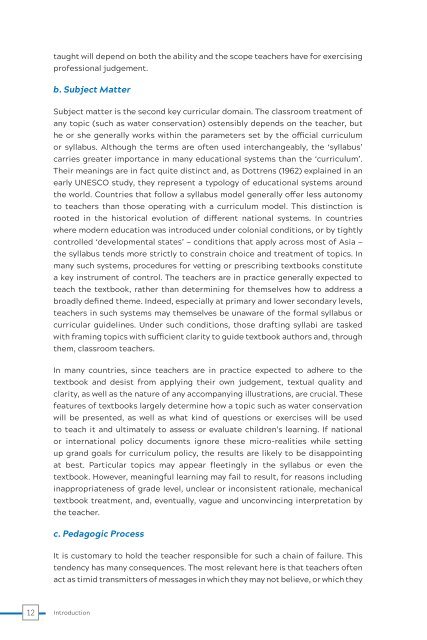Rethinking Schooling for the 21st Century
UNESCO MGIEP officially launched 'Rethinking Schooling for the 21st Century: The State of Education, Peace and Sustainable Development and Global Citizenship' in 2017 at the UNESCO General Conference. This study analyses how far the ideals of SDG 4.7 are embodied in policies and curricula across 22 Asian countries and establishes benchmarks against which future progress can be assessed. It also argues forcefully that we must redefine the purposes of schooling, addressing the fundamental challenges to efforts to promote peace, sustainability and global citizenship through education.
UNESCO MGIEP officially launched 'Rethinking Schooling for the 21st Century: The State of Education, Peace and Sustainable Development and Global Citizenship' in 2017 at the UNESCO General Conference. This study analyses how far the ideals of SDG 4.7 are embodied in policies and curricula across 22 Asian countries and establishes benchmarks against which future progress can be assessed. It also argues forcefully that we must redefine the purposes of schooling, addressing the fundamental challenges to efforts to promote peace, sustainability and global citizenship through education.
You also want an ePaper? Increase the reach of your titles
YUMPU automatically turns print PDFs into web optimized ePapers that Google loves.
taught will depend on both <strong>the</strong> ability and <strong>the</strong> scope teachers have <strong>for</strong> exercising<br />
professional judgement.<br />
b. Subject Matter<br />
Subject matter is <strong>the</strong> second key curricular domain. The classroom treatment of<br />
any topic (such as water conservation) ostensibly depends on <strong>the</strong> teacher, but<br />
he or she generally works within <strong>the</strong> parameters set by <strong>the</strong> official curriculum<br />
or syllabus. Although <strong>the</strong> terms are often used interchangeably, <strong>the</strong> ‘syllabus’<br />
carries greater importance in many educational systems than <strong>the</strong> ‘curriculum’.<br />
Their meanings are in fact quite distinct and, as Dottrens (1962) explained in an<br />
early UNESCO study, <strong>the</strong>y represent a typology of educational systems around<br />
<strong>the</strong> world. Countries that follow a syllabus model generally offer less autonomy<br />
to teachers than those operating with a curriculum model. This distinction is<br />
rooted in <strong>the</strong> historical evolution of different national systems. In countries<br />
where modern education was introduced under colonial conditions, or by tightly<br />
controlled ‘developmental states’ — conditions that apply across most of Asia —<br />
<strong>the</strong> syllabus tends more strictly to constrain choice and treatment of topics. In<br />
many such systems, procedures <strong>for</strong> vetting or prescribing textbooks constitute<br />
a key instrument of control. The teachers are in practice generally expected to<br />
teach <strong>the</strong> textbook, ra<strong>the</strong>r than determining <strong>for</strong> <strong>the</strong>mselves how to address a<br />
broadly defined <strong>the</strong>me. Indeed, especially at primary and lower secondary levels,<br />
teachers in such systems may <strong>the</strong>mselves be unaware of <strong>the</strong> <strong>for</strong>mal syllabus or<br />
curricular guidelines. Under such conditions, those drafting syllabi are tasked<br />
with framing topics with sufficient clarity to guide textbook authors and, through<br />
<strong>the</strong>m, classroom teachers.<br />
In many countries, since teachers are in practice expected to adhere to <strong>the</strong><br />
textbook and desist from applying <strong>the</strong>ir own judgement, textual quality and<br />
clarity, as well as <strong>the</strong> nature of any accompanying illustrations, are crucial. These<br />
features of textbooks largely determine how a topic such as water conservation<br />
will be presented, as well as what kind of questions or exercises will be used<br />
to teach it and ultimately to assess or evaluate children’s learning. If national<br />
or international policy documents ignore <strong>the</strong>se micro-realities while setting<br />
up grand goals <strong>for</strong> curriculum policy, <strong>the</strong> results are likely to be disappointing<br />
at best. Particular topics may appear fleetingly in <strong>the</strong> syllabus or even <strong>the</strong><br />
textbook. However, meaningful learning may fail to result, <strong>for</strong> reasons including<br />
inappropriateness of grade level, unclear or inconsistent rationale, mechanical<br />
textbook treatment, and, eventually, vague and unconvincing interpretation by<br />
<strong>the</strong> teacher.<br />
c. Pedagogic Process<br />
It is customary to hold <strong>the</strong> teacher responsible <strong>for</strong> such a chain of failure. This<br />
tendency has many consequences. The most relevant here is that teachers often<br />
act as timid transmitters of messages in which <strong>the</strong>y may not believe, or which <strong>the</strong>y<br />
12<br />
Introduction

















